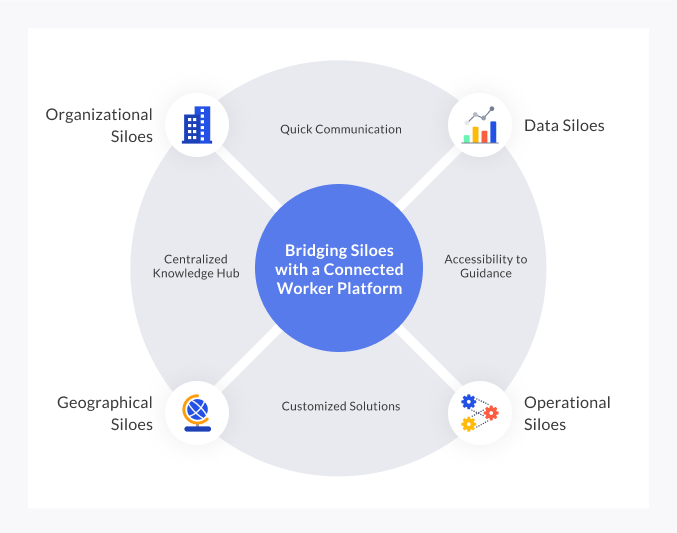Collaboration and synergy are some of the most important aspects of work. Sadly, 39 percent of employees still believe teams in their company don’t collaborate enough. When this happens and each cell is moving in separate directions to satisfy its own agenda, a silo ensues and the agenda of the organism (the organization) will inevitably suffer. In this article, we examine how you can eliminate connect silos to promote knowledge sharing, communication, and collaboration in your workplace.
What are silos?
A silo is when a business’s culture is such that different teams and departments cannot – and do not – collaborate effectively. It may be because of unhealthy competition, political manoeuvres, or as common in capital-intensive industries, lack of collaboration tools for deskless workers. This may lead to costly delays, reworks, and a loss in morale and productivity.
There are four major groups of silos: organizational, operational, data, and geographical.
- Silos are organizational if silo mentality is deep-rooted in the organization and is the prevailing attitude among stakeholders. When this happens, information is routinely withheld and interdepartmental communication and collaboration are almost non-existent. This is prevalent in heavy industries where organizational structure is still often old-school and most communications are top-down- leading to chaos. Only a culture change (with sustained effort and enforcement) can satisfactorily overcome organizational silos.
- Operational silos occur when the organization’s day-to-day activities and working models are built in such a way that collaboration is discouraged. Unlike organizational silos where stakeholders have more or less been trained to work alone, operational silos are usually a result of inadequate collaboration tools (some 40% of deskless workers don’t have access to collaboration tools!) or little motivation to collaborate.
- Data silos are caused by an overabundance of un-integrated point solutions that house data separately from the whole. In the event of data silos, stakeholders are bombarded with isolated data that fails to provide the big picture and thus can seldom be used for decision making. In manufacturing and construction where digitalization is mostly on the back burner, these data sets are commonly paper-based – leading to lost insights, and silos.
- Geographical silos occur usually in large organizations/projects and refer to a situation where information sharing and communication does not support all relevant languages or take into account the different time zones. An instance is in the oil & gas industry projects i.e Turnarounds where workers are multi-cultural and field operations where workers are often in remote locations, sometimes thousands of miles from the organization’s headquarters.
Connected Worker platforms: A digital solution for a digital age
A Connected Worker platform is digitalization’s solution to the silo problem. Three key areas where such a platform adds value to the shop floor is its accessibility, the real-time communication it fosters, and the ability for stakeholders to personalize the solution according to their preferences. We look at these areas below:

Communication
A Connected Worker platform makes communication easy, more inclusive, and less awkward. On the platform, workers can more quickly be notified of the happenings in the organization, and project alignment can be accomplished by assigning tasks to teams or individual workers with accompanying due dates.
Also, teams whose work is interdependent can have a nexus on the platform for smooth and timely communication. Field technicians, for example, will have a real-time connection with the office to quickly resolve potential bottlenecks and managers will be able to monitor job progress with digital inspections. Plant managers, on the other hand, can monitor real-time machine data in line with digital maintenance procedures.
Knowledge Hub
Additionally, a Connected Worker platform acts as a knowledge hub where archives of work-related documents are stored for easy and convenient access. For the deskless workforce, an opportunity to access important information and have real-time communication with their office colleagues adds bounds of value to their work and makes them feel more included in the affairs of the organization.
Accessibility
In addition to robust search features for quick access to critical information like safety protocols or SOPs, a Connected Worker platform also helps workers get remote guidance via virtual meetings with their managers.
Instant messaging and offline functionality allows them to ask questions, note observations, and submit reports to line managers from anywhere at any time. And in cases where sensitive documents are at play, physical meetings can be scheduled right from the platform.
Customization
A good Connected Worker platform should be customizable based on use-cases and the preferences of workers. The benefit of personalization is that different teams can derive value based on their unique KPI’s. The finance team for example can tailor the platform to monitor inventory investments and potential cost overruns.
Final thoughts
At this point, it’s important to emphasize that having a Connected Worker platform is pointless without actively developing a Connected Worker culture. Silos usually begin from the top all the way through the entire organization and to connect them, change has to start from the top. The new tools and working models will start from the management and trickle down from the heads of department to individual workers.
A culture where physical collaboration is absent will not suddenly translate into online collaboration. The importance of information sharing, communication, and collaboration should be emphasized when on-boarding new workers.
When designing Connected Worker solutions for your team, there are several non-negotiables – key elements that are vital for seamless collaboration in the shop floor. We’ve covered these elements extensively in our blog: ‘The Anatomy of a Great Connected Worker Platform‘
Why Maximl?
Maximl’s Connected Worker platform helps factories digitize their processes and enable standard work on the field across safety, quality, and maintenance operations. Our mobile-first and low-code platform is purpose built to drive adoption among the last mile workers.



